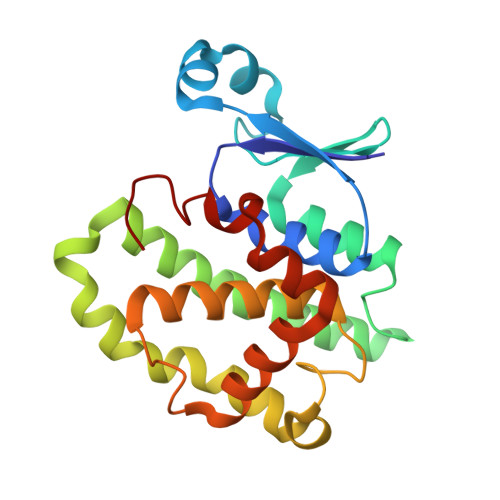Contribution of Glycine 146 to a Conserved Folding Module Affecting Stability and Refolding of Human Glutathione Transferase P1-1
Kong, G.K.-W., Polekhina, G., McKinstry, W.J., Parker, M.W., Dragani, B., Aceto, A., Paludi, D., Principe, D.R., Mannervik, B., Stenberg, G.(2003) J Biological Chem 278: 1291-1302
- PubMed: 12414796
- DOI: https://doi.org/10.1074/jbc.M209581200
- Primary Citation of Related Structures:
1MD3, 1MD4 - PubMed Abstract:
In human glutathione transferase P1-1 (hGSTP1-1) position 146 is occupied by a glycine residue, which is located in a bend of a long loop that together with the alpha6-helix forms a substructure (GST motif II) maintained in all soluble GSTs. In the present study G146A and G146V mutants were generated by site-directed mutagenesis in order to investigate the function played by this conserved residue in folding and stability of hGSTP1-1. Crystallographic analysis of the G146V variant, expressed at the permissive temperature of 25 degrees C, indicates that the mutation causes a substantial change of the backbone conformation because of steric hindrance. Stability measurements indicate that this mutant is inactivated at a temperature as low as 32 degrees C. The structure of the G146A mutant is identical to that of the wild type with the mutated residue having main-chain bond angles in a high energy region of the Ramachandran plot. However even this Gly --> Ala substitution inactivates the enzyme at 37 degrees C. Thermodynamic analysis of all variants confirms, together with previous findings, the critical role played by GST motif II for overall protein stability. Analysis of reactivation in vitro indicates that any mutation of Gly-146 alters the folding pathway by favoring aggregation at 37 degrees C. It is hypothesized that the GST motif II is involved in the nucleation mechanism of the protein and that the substitution of Gly-146 alters this transient substructure. Gly-146 is part of the buried local sequence GXXh(T/S)XXDh (X is any residue and h is a hydrophobic residue), conserved in all GSTs and related proteins that seems to behave as a characteristic structural module important for protein folding and stability.
- Biota Structural Biology Laboratory, St. Vincent's Institute of Medical Research, Fitzroy, Victoria 3065, Australia.
Organizational Affiliation:


















